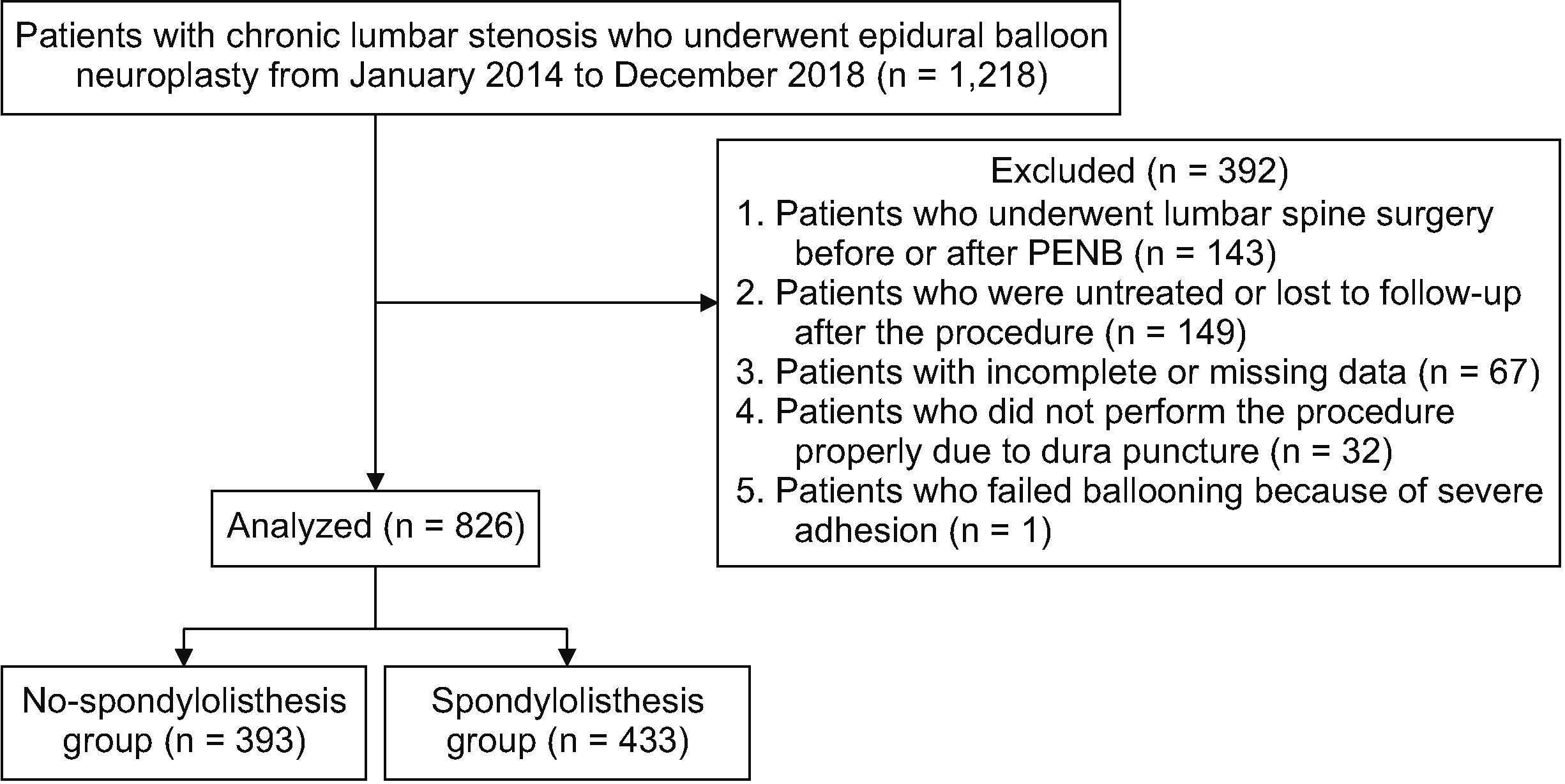1. Matz PG, Meagher RJ, Lamer T, Tontz WL Jr, Annaswamy TM, Cassidy RC, et al. 2016; Guideline summary review: an evidence-based clinical guideline for the diagnosis and treatment of degenerative lumbar spondylolisthesis. Spine J. 16:439–48. DOI:
10.1016/j.spinee.2015.11.055. PMID:
26681351.
2. Eismont FJ, Norton RP, Hirsch BP. 2014; Surgical management of lumbar degenerative spondylolisthesis. J Am Acad Orthop Surg. 22:203–13. DOI:
10.5435/JAAOS-22-04-203. PMID:
24668350.
5. Weinstein JN, Lurie JD, Tosteson TD, Hanscom B, Tosteson AN, Blood EA, et al. 2007; Surgical versus nonsurgical treatment for lumbar degenerative spondylolisthesis. N Engl J Med. 356:2257–70. DOI:
10.1056/NEJMoa070302. PMID:
17538085. PMCID:
PMC2553804.
6. Sencan S, Ozcan-Eksi EE, Cil H, Tay B, Berven S, Burch S, et al. 2017; The effect of transforaminal epidural steroid injections in patients with spondylolisthesis. J Back Musculoskelet Rehabil. 30:841–6. DOI:
10.3233/BMR-160543. PMID:
28372316.
7. García-Ramos CL, Valenzuela-González J, Baeza-Álvarez VB, Rosales-Olivarez LM, Alpízar-Aguirre A, Reyes-Sánchez A. 2020; Lumbar degenerative spondylolisthesis II: treatment and controversies. Acta Ortop Mex. 34:433–40. DOI:
10.35366/99144. PMID:
34020526.
9. Helm S 2nd, Racz GB, Gerdesmeyer L, Justiz R, Hayek SM, Kaplan ED, et al. 2016; Percutaneous and endoscopic adhesiolysis in managing low back and lower extremity pain: a systematic review and meta-analysis. Pain Physician. 19:E245–82. DOI:
10.36076/ppj/2016.19.E245.
11. Karm MH, Choi SS, Kim DH, Park JY, Lee S, Park JK, et al. 2018; Percutaneous epidural adhesiolysis using inflatable balloon catheter and balloon-less catheter in central lumbar spinal stenosis with neurogenic claudication: a randomized controlled trial. Pain Physician. 21:593–606. DOI:
10.36076/ppj.2018.6.593. PMID:
30508987.
12. Choi SS, Joo EY, Hwang BS, Lee JH, Lee G, Suh JH, et al. 2014; A novel balloon-inflatable catheter for percutaneous epidural adhesiolysis and decompression. Korean J Pain. 27:178–85. DOI:
10.3344/kjp.2014.27.2.178. PMID:
24748948. PMCID:
PMC3990828.
13. Choi SS, Lee JH, Kim D, Kim HK, Lee S, Song KJ, et al. 2016; Effectiveness and factors associated with epidural decompression and adhesiolysis using a balloon-inflatable catheter in chronic lumbar spinal stenosis: 1-year follow-up. Pain Med. 17:476–87. DOI:
10.1093/pm/pnv018. PMID:
26814254.
14. Karm MH, Yoon SH, Seo DK, Lee S, Lee Y, Cho SS, et al. 2019; Combined epidural adhesiolysis and balloon decompression can be effective in intractable lumbar spinal stenosis patients unresponsive to previous epidural adhesiolysis. Medicine (Baltimore). 98:e15114. DOI:
10.1097/MD.0000000000015114. PMID:
30985668. PMCID:
PMC6485831.
16. Moon DE, Park HJ, Kim YH. 2015; Assessment of clinical outcomes of cervical epidural neuroplasty using a Racz-catheter and predictive factors of efficacy in patients with cervical spinal pain. Pain Physician. 18:E163–70. DOI:
10.36076/ppj/2015.18.E163. PMID:
25794215.
17. Kim DH, Cho SS, Moon YJ, Kwon K, Lee K, Leem JG, et al. 2017; Factors associated with successful responses to transforaminal balloon adhesiolysis for chronic lumbar foraminal stenosis: retrospective study. Pain Physician. 20:E841–8. DOI:
10.36076/ppj.20.5.E841. PMID:
28934790.
18. Schizas C, Theumann N, Burn A, Tansey R, Wardlaw D, Smith FW, et al. 2010; Qualitative grading of severity of lumbar spinal stenosis based on the morphology of the dural sac on magnetic resonance images. Spine (Phila Pa 1976). 35:1919–24. DOI:
10.1097/BRS.0b013e3181d359bd. PMID:
20671589.
19. Lee S, Lee JW, Yeom JS, Kim KJ, Kim HJ, Chung SK, et al. 2010; A practical MRI grading system for lumbar foraminal stenosis. AJR Am J Roentgenol. 194:1095–8. DOI:
10.2214/AJR.09.2772. PMID:
20308517.
20. Meyerding HW. 1933; Diagnosis and roentgenologic evidence in spondylolisthesis. Radiology. 20:108–20. DOI:
10.1148/20.2.108.
21. Hanson DS, Bridwell KH, Rhee JM, Lenke LG. 2002; Correlation of pelvic incidence with low- and high-grade isthmic spondylolisthesis. Spine (Phila Pa 1976). 27:2026–9. DOI:
10.1097/00007632-200209150-00011. PMID:
12634563.
22. Gallizzi M, Gagnon C, Harden RN, Stanos S, Khan A. 2008; Medication Quantification Scale Version III: internal validation of detriment weights using a chronic pain population. Pain Pract. 8:1–4. DOI:
10.1111/j.1533-2500.2007.00163.x. PMID:
18211588.
23. Kalichman L, Kim DH, Li L, Guermazi A, Berkin V, Hunter DJ. 2009; Spondylolysis and spondylolisthesis: prevalence and association with low back pain in the adult community-based population. Spine (Phila Pa 1976). 34:199–205. DOI:
10.1097/BRS.0b013e31818edcfd. PMID:
19139672. PMCID:
PMC3793342.
24. Bydon M, Alvi MA, Goyal A. 2019; Degenerative lumbar spondylolisthesis: definition, natural history, conservative management, and surgical treatment. Neurosurg Clin N Am. 30:299–304. DOI:
10.1016/j.nec.2019.02.003. PMID:
31078230.
25. Faldini C, Pagkrati S, Acri F, Miscione MT, Francesconi D, Giannini S. 2007; Surgical treatment of symptomatic degenerative lumbar spondylolisthesis by decompression and instrumented fusion. J Orthop Traumatol. 8:128–33. DOI:
10.1007/s10195-007-0079-7. PMCID:
PMC4874964.
26. Weinstein JN, Lurie JD, Tosteson TD, Zhao W, Blood EA, Tosteson AN, et al. 2009; Surgical compared with nonoperative treatment for lumbar degenerative spondylolisthesis. four-year results in the Spine Patient Outcomes Research Trial (SPORT) randomized and observational cohorts. J Bone Joint Surg Am. 91:1295–304. DOI:
10.2106/JBJS.H.00913. PMID:
19487505. PMCID:
PMC2686131.
27. Fischgrund JS, Mackay M, Herkowitz HN, Brower R, Montgomery DM, Kurz LT. 1997; 1997 Volvo Award winner in clinical studies. Degenerative lumbar spondylolisthesis with spinal stenosis: a prospective, randomized study comparing decompressive laminectomy and arthrodesis with and without spinal instrumentation. Spine (Phila Pa 1976). 22:2807–12. DOI:
10.1097/00007632-199712150-00003. PMID:
9431616.
28. Fischgrund JS. 2004; The argument for instrumented decompressive posterolateral fusion for patients with degenerative spondylolisthesis and spinal stenosis. Spine (Phila Pa 1976). 29:173–4. DOI:
10.1097/01.BRS.0000111142.76601.1A. PMID:
14722410.
30. Freedman MK, Hilibrand AS, Blood EA, Zhao W, Albert TJ, Vaccaro AR, et al. 2011; The impact of diabetes on the outcomes of surgical and nonsurgical treatment of patients in the spine patient outcomes research trial. Spine (Phila Pa 1976). 36:290–307. DOI:
10.1097/BRS.0b013e3181ef9d8c. PMID:
21270715. PMCID:
PMC4005359.
31. Kim SH, Choi WJ, Suh JH, Jeon SR, Hwang CJ, Koh WU, et al. 2013; Effects of transforaminal balloon treatment in patients with lumbar foraminal stenosis: a randomized, controlled, double-blind trial. Pain Physician. 16:213–24. DOI:
10.36076/ppj.2013/16/213. PMID:
23703408.
35. Breivik H, Borchgrevink PC, Allen SM, Rosseland LA, Romundstad L, Hals EK, et al. 2008; Assessment of pain. Br J Anaesth. 101:17–24. DOI:
10.1093/bja/aen103. PMID:
18487245.
36. Kim DY, Lee SH, Lee HY, Lee HJ, Chang SB, Chung SK, et al. 2005; Validation of the Korean version of the Oswestry disability index. Spine (Phila Pa 1976). 30:E123–7. DOI:
10.1097/01.brs.0000157172.00635.3a. PMID:
15738775.





 PDF
PDF Citation
Citation Print
Print



 XML Download
XML Download